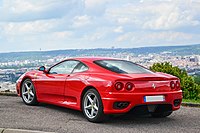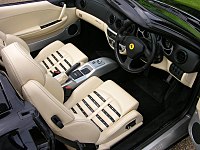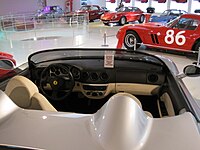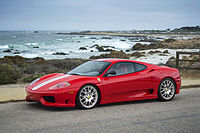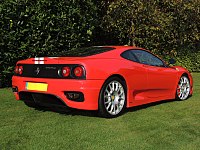Ferrari 360
| Ferrari 360 | |
|---|---|
 | |
| Overview | |
| Manufacturer | Ferrari |
| Production | 1999–2004 |
| Model years | 2000–2005 |
| Assembly | Italy:Maranello |
| Designer | Goran Popović atPininfarina[1][2][3] |
| Body and chassis | |
| Class | Sports car(S) |
| Body style | 2-doorberlinetta 2-doorspider |
| Layout | Longitudinal,Rear mid-engine, rear-wheel drive |
| Powertrain | |
| Engine | 3.6 L (3,586 cc)Tipo F131V8 |
| Transmission | 6-speedmanual 6-speed 'F1'Grazianoautomated manual |
| Dimensions | |
| Wheelbase | 2,600 mm (102.4 in) |
| Length | 4,477 mm (176.3 in) |
| Width | 1,922 mm (75.7 in) |
| Height | 1,214 mm (47.8 in) |
| Curb weight | 1,493 kg (3,291 lb) (Modena)[4] 1,553 kg (3,424 lb) (Spider)[5] |
| Chronology | |
| Predecessor | Ferrari F355 |
| Successor | Ferrari F430 |
TheFerrari 360(Type F131) is a two-seater, mid-engine, rear wheel drivesports carmanufactured by Italian automotive manufacturerFerrarifrom 1999 until 2004. It succeeded theFerrari F355and was replaced by theFerrari F430in 2004.
Development history
[edit]Ferrari partnered withAlcoato produce an entirely new all-aluminium space-frame chassis that was 40% stiffer than its predecessor's which had utilized steel. The design was 28% lighter despite a 10% increase in overall dimensions. Along with a lightweight frame the newPininfarinabody styling deviated from traditions of the previous decade's sharp angles and flip-up headlights. The new V8 engine utilises a 3.6-litre capacity, a flat-plane crankshaft, and titanium connecting rods. The engine generates a power output of 400 PS (294 kW; 395 hp). According to Ferrari, weight was reduced by 60 kg (130 lb) and the 0 to 100 km/h (62 mph) acceleration time improved from 4.7 to 4.5 seconds.
The first model to be produced was the360 Modena,followed later by the360 Spiderand a special edition, theChallenge Stradale.The Challenge Stradale was the high-performance road-legal version of the 360 produced by the factory, featuringcarbon ceramicbrakes (from theEnzo), track-tuned suspension, aerodynamic gains, weight reduction, power improvements and revised gearbox software among its track-focused brief. There were 8,800 Modenas and 7,565 Spiders produced worldwide. There were 4,199 built for the US market—1,810 Modenas (coupes) and 2,389 Spiders (convertibles). Of those numbers, there were only 469 Modenas and 670 Spiders that were produced with a gated 6-speedmanual transmissionas opposed to the "F1" single-clutchautomated manual transmission.[7]
In addition to this were the low-volume factory race cars and a one-off Barchetta variant. The race cars were all derived from the 360 Modena and for the first time produced as a separate model in their own right (compared to being aretrofit kitin previous years). While the Barchetta was based on the Spider variant. The first race car was the 360 Modena Challenge, used in a one-make series; the factory-built racing cars were prepared by the official tuner,Michelotto,who also developed the 360 N-GT. The N-GT was a 360 Challenge car evolved even further to compete in theFIAN-GT racing class alongside other marques such asPorsche.
Road models
[edit]Modena
[edit]The first model of the 360 to be produced was the Modena, named after the town ofModena,the birthplace ofEnzo Ferrari.Transmission options were a 6-speedmanual transmission,or the electrohydraulic-actuated "F1"automated manual transmissionwith a gearbox built byGraziano Trasmissioni.
The 360 Modena went into production in 1999 and remained in production until 2005 when it was replaced by theF430.The Modena was followed two years later by the 360 Spider, Ferrari's 20th road-goingconvertiblewhich at launch overtook sales of the Modena. Other than weight, the Spider's specifications matched those of the Modena almost exactly.
Spider
[edit]The Ferrari 360 Spider was unveiled at the2000 Geneva Motor Show.
The 360 was designed with a convertible variant in mind; since removing the roof of a coupe reduces thetorsional rigidity,the 360 was built for strength in other areas. Ferrari designers strengthened the sills, stiffened the front of the floorpan and redesigned the windscreen frame. The rear bulkhead had to be stiffened to cut out engine noise from the cabin. The convertible's necessary dynamic rigidity is provided by additional side reinforcements and a cross brace in front of the engine. Passenger safety is ensured by a strengthened windscreen frame androll bars.
The 360 Spider displays a curvilinear waistline. The fairings imply the start of a roof, and stable roll bars are embedded in these elevations. Due to use of light aluminium construction throughout, the Spider weighs in only 60 kg (130 lb) heavier than thecoupé.
As with the Modena version, its 3.6 L (3,586 cc) V8 generating a power output of 400 PS (294 kW; 395 hp) is on display under a glass engine cover. The engine — confined in space by the convertible's top's storage area — acquires additional air supply through especially large side air intakes. Theintake manifoldswere moved towards the centre of the engine between the air supply conduits in the Spider's engine compartment, as opposed to lying apart as with the Modena. In terms of performance, the 0-97 km/h (60 mph) acceleration time was slightly slower due to the slight weight increase, and the top speed was reduced.
Despite the car's mid-mounted V8 engine, the electrically operated top is able to stow into the compartment when not in use. The convertible top was available in black, blue, grey and beige colours.
Dimensions
[edit]- Overall: length 4,477 mm (176.3 in)
- Overall: width 1,922 mm (75.7 in)
- Height: 1,235 mm (48.6 in)
- Wheelbase: 2,600 mm (102.4 in)
- Front track: 1,669 mm (65.7 in)
- Rear track: 1,617 mm (63.7 in)
- Weight: 1,350 kg (2,976 lb)
- Curb weight:1,553 kg (3,424 lb)[5]
- Weight distribution:42/58% front/rear
- Fuel capacity:95 L (25 US gal; 21 imp gal)
Specifications (Modena and Spider)
[edit]Engine
[edit]
- Type: 90° V8 F1310-00
- Bore & stroke: 85 mm × 79 mm (3.35 in × 3.11 in)
- Total displacement: 3,586 cc (3.6 L; 218.8 cu in)
- Redline: 8,500 rpm
- Maximum power: 400 PS (294 kW; 395 hp) at 8,500 rpm[4]
- Maximum torque: 373 N⋅m (275 lb⋅ft) at 4,750 rpm[8]
Performance
[edit]- Top speed: Redline limited - 282 km/h (175 mph)[9][10]/ Manufacturer claim - 295 km/h (183 mph)[11]
- Lift-to-drag ratio:-0.73:1
- Acceleration:
- 0-60 km/h (37 mph): 2.47 seconds[12]
- 0-97 km/h (60 mph): 4.6 seconds[9][10]
- 0-100 km/h (62 mph): 4.98 seconds[12]
- 0-120 km/h (74.5 mph): 6.79 seconds[12]
- 0-160 km/h (100 mph): 11.1 seconds[9]/ 11.7 seconds[10]
- 0-210 km/h (130 mph): 21.9 seconds[10]
- Standing1⁄4mile (402 m):13.1–13.2 seconds at 170.6–177.0 km/h (106–110 mph)[9][10]
- Standing kilometer: 23.74 seconds[12]
- Braking: 110 km/h (70 mph)-0 mph: 165–175 ft (50–53 m)[9]
- Lateral acceleration: 0.90g
- Speed through 600 ft (180 m) slalom: 111.0 km/h (69.0 mph)
- EPAfuel economy:
- Est. range:
- City: 250 mi (400 km)
- High way: 375 mi (604 km)
Barchetta
[edit]TheFerrari 360 Barchetta(serial number 120020)[14]is a one-off based on the Ferrari 360 Spider which was commissioned byGianni Agnelliin 2000 as a wedding present for the thenFiatchairman and president ofFerrari,Luca Cordero di Montezemolo.[15]The car bears heavy resemblance to its donor with the only differences being the removal of the soft top system and roll bars, different engine cover and the addition of a visor in place of a windshield for better airflow over the car. Performance of the car remains the same as its donor and the car features Argento Nurburgring exterior paint with redpinstriping.The interior is black leather with cream fabric and features fabric seats with matching stitching, the words 360 Barchetta embroidered on the dashboard and a paddle-shift gearbox.
Challenge Stradale
[edit]Inspired by the 360 Modena Challenge racing car series, the Challenge Stradale is the track-focused iteration of the 360 Modena which followed on in concept from the track focused F355 "Fiorano", which featured the "Fiorano Handling Pack" introduced in the final year of the Ferrari F355. The focus in development of the car was primarily on improving its track performance credentials by concentrating on handling, braking and weight reduction characteristics, which are essential in pure racing cars. Ferrari engineers designed the car from the outset with a goal of 20% track day use in mind and 80% road use. With only a small 25 PS (18 kW; 25 hp) improvement in engine power from the Modena (and boasting an improved power-to-weight ratio), the Challenge Stradale accelerates from 0 to 100 km/h (62 mph) in 4.1 seconds according to Ferrari. Systematic improvements were achieved to the setup and feel of the whole car; throttle response from the digital throttle was ratcheted up and feedback through the steering wheel was enhanced. Ceramic brakes borrowed from the Enzo, some lower weight parts and a FHP handling pack, enabled the Challenge Stradale to claim a 3.5 second improvement per lap of itsFiorano Circuitcompared to the Modena.
In total, the Challenge Stradale is up to 110 kg (240 lb) lighter than the standard Modena if all the lightweight options are specified such as deleted radio, lexan (plexiglass) door windows and Alcantara fabric (instead of the leather option). As much as 74 kg (163 lb) was saved by lightening the bumpers, stripping the interior of its sound deadening and carbon mirrors and making the optional Modena carbon seats standard. Resin Transfer Moulding was utilised for the bumpers and skirts, a carry over from the Challenge cars which resulted in lighter bumpers than those on the Modena. The engine and transmission weight was lightened by 11 kg (24 lb) through the use of a smaller, lighter weight sports exhaust back box and valved exit pipes. The Challenge Stradale also gotBrembocarbon ceramic brakes as standard (which later became standard fitment on the F430) which shaved 16 kg (35 lb) off the curb weight and improved handling by reducing unsprung weight and completely eliminating brake fade, as well as lightweight wheels specially made byBBS.Cars fitted with the centre console stereo option, sub speaker box behind the seats and glass side windows re-gained approximately 30 kg (66 lb) over the best selected options.
Dimensions
[edit]- Overall length: 4,477 mm (176.3 in)
- Overall width: 1,922 mm (75.7 in)
- Height: 1,199 mm (47.2 in)
- Wheelbase: 2,600 mm (102.4 in)
- Front track: 1,669 mm (65.7 in)
- Rear track: 1,617 mm (63.7 in)
- Dry weight: 1,180 kg (2,601 lb)
- Curb weight: 1,430 kg (3,153 lb)[6]
- Fuel capacity: 95 L (25 US gal; 21 imp gal)
Engine
[edit]- Type:Naturally aspirated90°V8 engineF131
- Position:Longitudinally-mountedRear mid-engine, rear-wheel-drive layout
- Valvetrain: DOHC 5 valves per cylinder
- Fuel feed:BoschMotronic7.3 fuel injection
- Bore X stroke: 85 mm × 79 mm (3.35 in × 3.11 in)
- Total displacement: 3,586 cc (3.6 L; 218.8 cu in)
- Rev limiter: 8,650 rpm
- Compression ratio: 11.2:1
- Max. power: 425 PS (419 hp; 313 kW) at 8,500 rpm
- Max. torque: 373 N⋅m; 275 lbf⋅ft (38 kg⋅m) at 4,750 rpm
Performance
[edit]- 0-97 km/h (60 mph): 4.0 seconds[16]
- Top speed: Redline limited - 283 km/h (176 mph)[16]
- Downforce: about 270 kgf (2.6 kN) at 300 km/h (190 mph) (without rear wing)
- Lift to drag: about -1.1:1
Race models
[edit]360 Challenge
[edit]
Based on the 360 Modena road car, the 360 Challenge was an extensively reworked, track-oriented model intended to compete in Ferrari's one-make racing series called theFerrari Challenge.[17] It was only available with the electrohydraulic-actuatedautomated manual transmission.At the time of launch, Ferrari claimed the 360 Challenge accelerated from 0 to 100 km/h (62 mph) in 3.9 seconds (0.6 seconds quicker than the standard 360 Modena F1) and could corner and brake significantly faster than the road car due to added aerodynamic elements.Bremboracing provided the upgraded Gold coloured calipers and larger floating 2-piece discs, whileBoschprovided the race-oriented ABS software. The exhaust system was lightened substantially and was one of the main contributions to the increased power output over the standard engine (as ignition mapping was claimed to virtually be the same). For the road cars (even the Challenge Stradale) Ferrari used a valve system that made the car more socially acceptable at lower revs (and therefore able to pass drive-by noise tests).
Less than 200 were made and marketed by Ferrari as a pure race car, requiring purchasers to enter their Ferrari 360 Challenge into the Ferrari Challenge race series as a condition of sale.
Unlike the previous Challenge race series, which utilised an F355 road car with a dealer-installed 'challenge upgrade' kit, the 360 Challenge was a factory-built track car. The enhanced driving characteristics and substantial weight reduction meant the car could comfortably outperform its road-going counterpart even though power from the 3.6-litre engine was claimed to be similar.
The 360 Challenge featured a stripped-down race-oriented interior with the stereo, electric windows and locks, soundproofing, airbags, air-conditioning, and even the handbrake removed. The seats and restraints were replaced by a single carbon-fibre racing seat andFIAapproved restraint harnesses, and a roll cage was fitted for safety along with a fire suppression system. The instrument cluster was reworked with a monochrome LCD to display vital engine data. The adaptive suspension of the road car was replaced by adjustable racing dampers, while larger brakes with extra cooling ducts were added.
Official performance figures
[edit]- Power (SAE net): 416 PS (306 kW; 410 hp) at 8,500 rpm
- Torque (SAE net): 286 lb⋅ft (388 N⋅m) at 4,750 rpm
- 0–100 km/h (0–62 mph): 3.9 seconds
- Top speed (limited): 298 km/h (185 mph)
- Kerb Weight: 1,250 kg (2,756 lb)
- Dry Weight: 1,169 kg (2,577 lb)
360 N-GT
[edit]
The Ferrari 360 N-GT was a 360 Challenge race car tuned by Michellotto for the N-GT category of the FIA GT Championship. It was the fastest version of the Ferrari 360[18]with the engine generating a power output of over 547 PS (402 kW; 540 hp) when derestricted. The 360 N-GT was capable of a top speed of around 310 km/h (190 mph) with a 0–97 km/h (60 mph) acceleration time of around 3 seconds.[19]It was the final car built through a Ferrari-Michelotto collaboration.[20]The most recent major victory achieved by a 360 Michelotto was by SB Race Engineering at the 2011 Britcar Championship, where the 360 N-GT, as on many occasions, outperformed the newer F430 GT.[21]
In 2002, a 360 N-GT was driven in theAustralian Nations Cup ChampionshipforGTstyle cars. Run by Prancing Horse Racing to replace the teams 360 Challenge and driven by highly successful Australian race driverJohn Bowe,the car would eventually place 3rd in the2002 championship.PHR then entered the Ferrari in the2002 Bathurst 24 Hourrace at the famousMount Panorama Circuit,whereBrad Jonesput the 360 N-GT on pole position. After running in 2nd place behind the7.0-litreHolden Monaro 427Cwhich would go on to win the race outright, the 360 N-GT lost its oil pressure. PHR then did an engine change in just 3 hours, only to have the replacement engine also lose oil pressure just under 3 hours later ending their race.[22]Bowe then finished 2nd in the2003 Nations Cup Championship[23]before the car was raced one last time in the2003 Bathurst 24 Hour,where it was run by Austrian-based team BE Racing. Driven byDavid Brabham,Andrea Montermini,Klaus Engelhorn andPhilipp Peter,the Ferrari qualified in 7th place and after running 3rd for a number of hours behind theHolden Monaros,was retired on lap 287.[24]
360 GT
[edit]
The Ferrari 360 GT is arace versionof the 360 Modena developed by theFerrari Corse Clientidepartment inMaranello,in collaboration with Michelotto Automobili to compete in the FIA N-GT class. Team JMB Giesseraced the cars during the2001 FIA GT Championship seasonand won the N-GT Cup for Drivers and the N-GT Cup for Teams.
From 2002 to 2004, Ferrari produced and sold 20 360 GTs to customers through their Corse Clienti department.
The 3.6-litre V8 engine was tuned to generate a power output of 436 PS (321 kW; 430 hp) which was a significant improvement over the 360 Challenge cars.
Significant additional weight reduction efforts were taken over the regular 360 Challenge cars such as lightening the wiring loom (saving 7 kg alone) as well as removing all unnecessary weight like air-conditioning brackets and doors which were now made from one-piece of carbon fibre along with the front compartment lid.
The Final results of all the weight reduction in the 360 GT's kerb weight was 91 kg (200 lb) over the 360 Challenge cars (1,070 kg or 2,354 lbs). Ballast was used to bring the car back up to the regulation limit of 1,100 kg (2,425 lb).[25]
360 GTC
[edit]
The Ferrari 360 GTC has been developed to replace the previous 360 GT. With akerb weightof 1,100 kg (2,425 lb) (with ballast), it was built since 2004 by Ferrari Corse Clienti department in collaboration with Michelotto Automobili to compete in the N-GT class. It made use of recent evolutions successfully race tested on the Ferrari 360 GT, with a sequential six-speedgearboxand a further improvedMagneti Marellielectronics package. Theaerodynamicsare substantially different from the 360 GT, given that the 360 GTC had been newlyhomologatedbyFIA/ACO from the Challenge Stradale, taking up from its basic elements: front bumper, side skirts, engine cover and double rear end.Wind tunnelresearch has led to a new system for the rear wing, with a notable improvement in verticaldownforce.The performance of the 3,586.3 cc (3.6 L) 90-degreeV8 enginehas been improved in terms of fuel consumption.
In 2009, a privately owned Veloqx-Prodrive Racing 360 raced de-restricted, fully tuned variations of the GT-C in endurance races around the world including Silverstone, Sebring and Le-Mans.
The original 360GT's power output was 451 PS (332 kW; 445 hp) at 8,750 rpm, the GTC bettered that raising peak power to 479 PS (352 kW; 472 hp) while still breathing through the mandatory 30.8 mm (1.21 in) air restrictors. (Without the mandatory [for racing in N-GT class] air restrictors in place the engine dyno's at 550 bhp (410 kW)).[citation needed]
Specifications
[edit]- Country of origin:Italy
- Introduced at: 2003Bologna Motor Show
- Body design:Pininfarina
- Weight: 1,000 kg (2,205 lb)
- Engine: F131 90° V8
- Engine Location: Mid, longitudinally mounted
- Displacement: 3,586 cc (3.6 L; 218.8 cu in)
- Valvetrain: five valves / cylinder,DOHC
- Fuel feed: Magneti Marelli MR3 Fuel injection
- Aspiration: naturally aspirated
- Gearbox: six-speed sequential
- Drive: rear wheel drive
Performance
[edit]- Power: 351 kW (477 PS; 471 bhp) at 8,750 rpm [558 PS; 410 kW (550 bhp) unrestricted]
- Torque: 440 N⋅m (325 lb⋅ft) at 6,500 rpm
- Power to displacement ratio: 131 hp/L (97 kW/L)
- Power-to-weight ratio: 472 hp/tonne (352 kW/tonne)
- Top speed: Over 320 km/h (200 mph)
- 0 to 100 km/h (62 mph): 4.2 seconds
Reviews
[edit]Chris Harris reported that the 360 Modena press car was "ludicrously quick" (two seconds faster to 161 km/h (100 mph) than the customer car they tested) and sounded more like a racing car than a street car, but the other cars were different. While performance claims for the 360 were equal to or higher than the previous model, whenCar and Drivertested a stock 360 it proved heavier and slower than its predecessor's claimed performance from five years before, this however can likely be attributed to choice of options fitted to the test car. Also US federal requirements for crash protection added weight back in for US designated models.[26][27][9]
References
[edit]- ^"The State of Italian Car Design".kars.com.au.30 November 2016.Retrieved30 January2020.
- ^"Ferrari 360 Modena".ecurie-cavallino.com(in French).Retrieved30 January2020.
- ^"Goran Popović".automotivedesignconference.com.Retrieved30 January2020.
- ^ab "Car and Driver Aston Martin DB7 Vantage vs. Porsche 911 Turbo, Ferrari 360 Modena F1"(PDF).
- ^ab "Car and DriverAston Martin DB7 vs. BMW Z8, Ferrari 360 Spider"(PDF).
- ^ab "Car and Driver 2004 Ferrari Challenge Stradale vs. Ford GT, Porsche 911 GT3"(PDF).
- ^Ahlgrim, Steve (March 2013). "2004 Ferrari 360 Modena Spider F1".Sports Car Market.25(3): 40–41.
- ^"Ferrari 360 Modena: Full Specification".channel4.com.Archived fromthe originalon 2007-09-26.Retrieved2007-09-01.
- ^abcdef"Car and Driver Aston Martin DB7 Vantage vs. Porsche 911 Turbo, Ferrari 360 Modena F1"(PDF).
- ^abcde"Car and DriverAston Martin DB7 vs. BMW Z8, Ferrari 360 Spider"(PDF).
- ^Covelllo, Mike (2003-06-01).Standard Catalog of Ferrari 1947-2003.Krause Publications.ISBN1440227969.[permanent dead link]
- ^abcd"Car November 1999".Archived fromthe originalon August 9, 2016.RetrievedJuly 24,2016.
- ^abc"Compare Side-by-Side".www.fueleconomy.gov.
- ^"Ferrari 360 Barchetta, serial number".Retrieved2018-01-12.
- ^"Ferrari 360 barchetta details".2012-10-11.Retrieved2018-01-12.
- ^ab"Car and Driver 2004 Ferrari Challenge Stradale vs. Ford GT, Porsche 911 GT3"(PDF).
- ^Neil, Dan (June 1, 2000)."Ferrari 360 Modena Challenge".Car and Driver.
- ^"2001 Ferrari 360 N-GT detail".mariobernardi.de.Retrieved31 May2015.
- ^"jmb-ferrari-360-n-gt-cavallin".postimg.org.Archived fromthe originalon 3 December 2017.Retrieved31 May2015.
- ^"testo storia".Michelotto History.Archived fromthe originalon 23 June 2015.Retrieved23 June2015.
- ^"SB Race Engineering Ferrari 360 Michelotto".SB Race Engineering.Retrieved23 June2015.
- ^"Natsoft Race Results".
- ^2003 Australian Nations Cup Championship - Outright Points, www.procar.com.au via web.archive.orgRetrieved on 19 September 2010
- ^Mount Panorama - Bathurst 23/11/2003 Bathurst 24hr 2003Archived2007-08-31 at theWayback MachineNational Software retrieved on 4 April 2008
- ^"Ferrari 360 GT and GTC".14 May 2007.Retrieved28 March2018.
- ^Harris, Chris (15 February 2011)."How Ferrari Spins".Jalopnik.
- ^"The Supercar Olympics. Car and Driver July 1995"(PDF).

